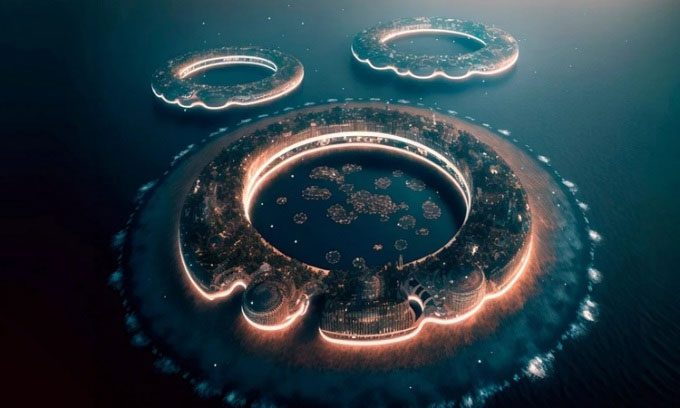The sustainable floating city built from recycled waste from the massive Great Pacific Garbage Patch is a unique architectural project designed by two architects from Argentina.
Using AI image generation tools, the duo proposed the construction of a super city aimed at addressing the issues surrounding the Great Pacific Garbage Patch, Tech Times reported on January 13. The project, named Polimeropolis, focuses on an autonomous floating city, serving as an alternative solution for migration into space. This design combines an eco-city with a smart city situated in the middle of the garbage patch, where underwater waste accumulates in the Northern Pacific.

Floating city design by Estudio Ficaccio Prieto. (Photo: Juan Manuel Prieto).
Polimeropolis consists of a series of urban areas arranged in a circular pattern, surrounding a vast lagoon on the sea. Some design features provide solutions to the issue of marine waste.
Advanced design limits microplastics intrusion through boundaries, filtering water and maintaining a clean environment for both humans and marine life by blocking waste. Any remaining plastic will be repurposed for the construction of the city. Polimeropolis aims for self-sufficiency by harnessing tidal movements, reverse osmosis, and cultivating local flora and fauna to generate electricity, water, and food.
This concept was developed by Estudio Ficaccio Prieto, an architectural firm in Argentina, due to concerns about the ever-growing plastic waste island and rising sea levels. Unlike any other city and production model, Polimeropolis seeks to clean the ocean rather than contribute to its pollution.
Prieto and his colleague Clara Focaccia showcased the design through aerial photos created by Midjourney, an AI tool specializing in generating realistic images from text prompts. AI artist Maxi Araya illustrated the technological aspects of the design. Prieto’s firm plans to implement the design and assemble a multidisciplinary team to further develop the project.


















































